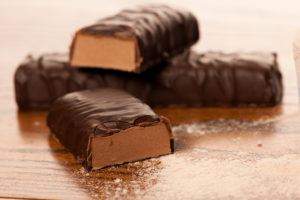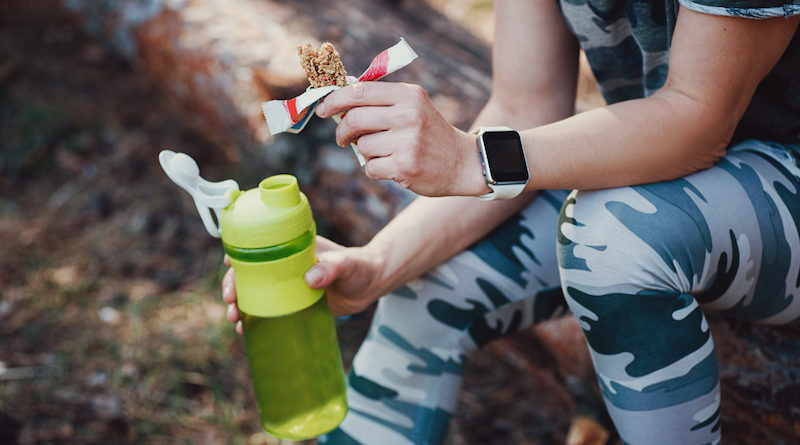How to Pick the Perfect Energy Bar
Tired of all the processed ingredients and high costs of store-bought energy bars? Here’s how you can make your own and skip some of the ingredients you might want to avoid.
It’s finally time: Lace up your hiking boots, tune up your bike and hit whatever trail, rec path or roadway is calling your name because summer is in full swing.
Whether you are taking advantage of the season with century rides, leisurely hikes or tackling some

trail runs, energy bars are a convenient way for many of us to get the energy we need to fuel our fun. And there is no shortage of bars to choose from either, which—as it turns out—can be both a blessing and a curse.
Choosing the “right” bar goes beyond just what tastes good and fits in your pocket. Unfortunately,
many energy bars are simply candy bars in disguise, loaded with highly processed ingredients that deliver on calories but little else.
Here we break down what ingredients you should include and which to steer clear of. The old adage that the best things come in small packages couldn’t be further from the truth because in this case the best energy bars don’t come in a package at all—you can make them at home at a fraction of the price with this easy recipe.
The Natural Ingredients
Most energy bars, store-bought or homemade, start out with good intentions and good ingredients. These might include a healthy mix of oats, nuts and natural sweeteners. Here’s what they do for you:
Dried Fruit
Dried fruit is an energy bar staple for a reason. Fruits provide our body with an accessible source of energy in the form of fructose to power our exercise. As a general rule, it is best to limit dried fruit because it packs a lot of sugar and calories into a very small volume, but that’s also exactly what makes it so perfect in bars. Raisins, dates, tart cherries and apricots all deliver on energy and serve as binding agents so your bars don’t fall apart.
Maple Syrup
Forget the fake and processed sugars you see listed in packaged bars. Maple syrup provides the sugar your body needs during exercise to keep your muscles fueled without all of those other processed sugar sources. Any Vermonter worth their grit knows pure maple syrup reigns supreme in terms of flavor, but that’s not the only reason to opt for the real stuff over fake. Pure maple syrup has some antioxidants, which can help the body repair and recover from exercise. Plus, a healthy dose of zinc boosts the immune system to ward off any illness that could sideline you.
Nuts and Seeds
Nothing is worse than feeling your stomach rumble when you’re only halfway through a workout. Straight carbs and sugar can only keep you satisfied for so long, which is where nuts and seeds come in. Rich in energy, protein, vitamins, minerals, antioxidants and healthy fats, nuts and seeds are a must for crafting your own bars. And talk about variety! Almonds, peanuts, cashews, walnuts, chia seeds, flax seeds, pumpkin seeds and so many more are an easy add-in that will give your bars major nutrition and a little crunch. Change out which nuts and seeds you use, as all have different vitamin and mineral profiles. There’s no need to limit yourself to just one!
Oats
Trail mix, granola and energy bars almost always include oats for an easy to digest, sustainable source of energy. Simple sugars from natural sources like fruit, honey and maple syrup provide plenty of energy, but like kindling on a fire, they burn out quickly. Oats still deliver on energy, but thanks to a good dose of soluble fiber, they have more staying power, providing longer- lasting energy. They are also nutrient-dense, packed with antioxidants including avenanthramides, a group of antioxidants with anti-inflammatory properties found in few other foods.
What Store-Bought Bars Add
If you’re making your own bar, you can get away with all the ingredients listed above. However, when companies mass-produce bars, they often have to look for ingredients that cost less, extend the shelf-life of the bar, or make it hold together better. Here’s what to watch out for:
Fractionated Palm Kernel Oil
If your chocolate-coated bar instantly turns into a gooey melted mess in your hand, then chances are this is on the ingredient list. This shelf-stable fat is highly processed and extremely high in saturated fat, more so than even butter. There are also numerous environmental concerns that make it a bad choice for our health and the health of our planet.
High Fructose Corn Syrup
It hardly seems worth mentioning as it’s no secret this chemically made sweetener is far from healthy, but that doesn’t stop it from cropping up in many packaged energy bars. The real concern when it comes to this sweet stuff is the ratio of glucose to fructose, which—as the name implies—is weighted towards fructose. Our digestive system can only handle so much fructose at a time. Too much fructose will result in diarrhea, cramping, gas and bloating. Not sweet!
Inulin
We know fiber is good for us, so a bar packed with dietary fiber seems like a healthy option, right? Not if all that fiber comes from inulin, a type of soluble fiber naturally found in foods that improves digestive health by providing a food source for good bacteria (probiotics) in our gut. The problem is that most of the inulin found in bars comes from chicory root, which can lead to digestive problems like gas, bloating and diarrhea when consumed in large quantities. Not exactly what you want midway through a day hike.
Soy Protein Isolate
Including protein in a bar is important for keeping hunger at bay for longer activities. Many energy bars offer protein-added options with this in mind; however, the quality of these proteins varies greatly and soy protein isolate is far from ideal. While whole soy foods can be a healthy protein source, the process of isolating the soy protein changes the health profile for the worse due to possible heavy metal contamination and interference in thyroid function.
Sugar Alcohols
Added to many bars to provide sweetness without the calories sugar provides, sugar alcohols sound almost too good to be true. That’s because they are. Listed most commonly as erythritol, mannitol, sorbitol, xylitol, or malitol, the reason these are lower calorie than regular sugar is because they are tough to digest—another case of an ingredient likely to cause digestive issues. In addition, an energy bar is supposed to provide energy (seriously, it’s in the name) and sugar alcohols fail to deliver on an accessible source of energy to power your activities.
Of course, the best solution is to make your own. These may not hold up as long as a store-bought bar or be quite as portable but you’ll have the satisfaction of knowing exactly what went into it.
For Jamie’s all-time favorite DIY energy bar recipe, click here.



